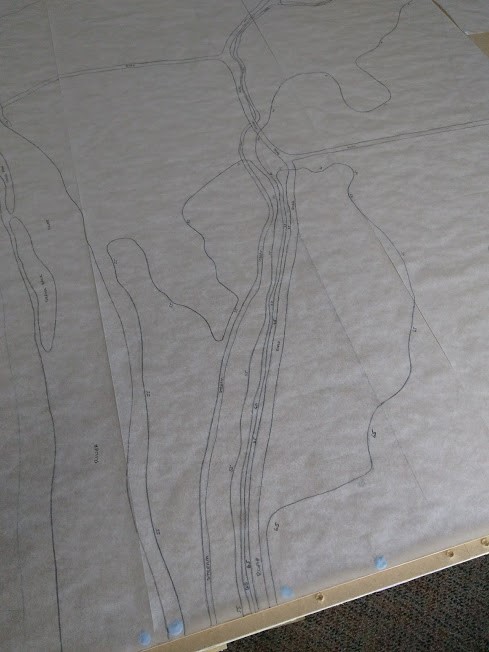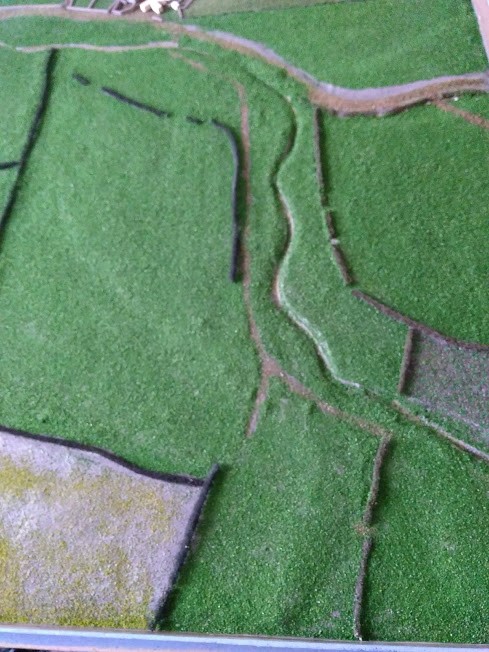In 2019 Mark Hornsby was appointed The Battlefilds Trust’s model maker in residence. with Phil Philo, chair of the NE&B(S) region, he published an article in Battlefield, the members magazine of the Battlefields Trust, discussing the production of the magnificent Piercebridge battlefield model.
 Fig.1 The finished model looking north along Dere Street toward Piercebridge. This 1/600 scale model is made up of eight boards, each 600mm (2’) square, to facilitate transportation, which come together to create a miniature landscape 2400mm x 1200mm (8’ x 4’). Each model infantry figure is 3mm high and all the soldiers, horses, cannon and wagons represent 1:1 those who fought in the battle.
Fig.1 The finished model looking north along Dere Street toward Piercebridge. This 1/600 scale model is made up of eight boards, each 600mm (2’) square, to facilitate transportation, which come together to create a miniature landscape 2400mm x 1200mm (8’ x 4’). Each model infantry figure is 3mm high and all the soldiers, horses, cannon and wagons represent 1:1 those who fought in the battle.
On 1 December 2017 a talk, “’Died valiantly fighting in the cause’: The Battle of Piercebridge 1st December 1642” by Battlefields Trust member, Phil Philo, was delivered at the George Hotel on the approach to the medieval bridge at Piercebridge. The occasion was the marking of the 375th anniversary of the Civil War battle which saw the Royalist William Cavendish, Earl of Newcastle’s, army force the crossing of the River Tees en route from Newcastle to York, and defeat Captain Hotham’s small Parliamentarian force. The talk was one of a series of heritage talks, walks and day schools, led by Tees Archaeology, highlighting the military importance of the River Tees river crossings, organized by Groundwork’s Heritage Lottery funded ‘River Tees Rediscovered’ project. (see The Great Civil War in the Tees Valley post)
In the audience of just over twenty brave souls who turned out on that wintery night was model maker Mark Hornsby. A recent resident in Piercebridge, like many he was largely unaware of the village’s Civil War story, which often goes unnoticed because of the hugely important Roman remains, particularly relating to the river crossing and fort. After the talk he shared his passion for all things military and military modelling with the speaker, suggested that he make a model of the Battle of Piercebridge and work with the BT to further develop the interpretation of the battle.
River Tees Rediscovered supported the idea with some funding support and Mark began working on the model, researching the topography of the area at the time, the units involved in the battle and the likely course of the battle itself. During this work other residents came forward with information, ranging from antiquarian publications to the possibility of carrying out fieldwork and the investigation of scatter concentrations of lead shot in local fields.
Fig.2.

In the absence of maps and information from the mid-17th century, a modern 1/25,000 ordnance survey map was used and the contours and details, such as the River Tees, streams, roads and field boundaries, were drawn onto the 8 x 600mm square base boards. These details were then copied onto grease proof paper and, using a contour scale of 5 metres on the ordnance survey map – this equalling 3mm high model contours – the contours were then cut from 3mm thick styrofoam, the highest contour being 9 sheets thick.
Fig. 3.

The contours were fixed in place, covered in a thin layer of plaster and then bandage impregnated with plaster (Modroc) to give strength. Once dry, another thin layer of plaster was added and smoothed out, using water and a soft paint brush.
Fig.4.

After drying and hardening, roads were added using shaped and smoothed air drying clay. The whole model was then coated in PVA adhesive, a fine sieved sand sprinkled onto it and then coated with a 50/50 mix of brown emulsion and PVA.
Fig.5.

This was left to dry for 48 hours, creating a very strong coat for the plaster and sealing the sand base. A dry brush of cream matt emulsion paint was then added. Detail, such as tracks, field boundaries, woods, etc., was then drawn on.
Fig.6.

Hedges, made of green scouring pads sprayed brown to give them the look of hedges in winter, were then super glued to the boards. Once all the hedges were fixed in place, roads and tracks were then added using two different coloured brown scatter flocks.
Fig.7.

The field areas were coated with PVA adhesive and various coloured flock scatters were added. These act as a base for the static grass later on.
Fig.8.

River and stream detail was added using larger pieces of sand and stone. Each piece was painted grey and then dry-brushed cream to define each stone.
Fig.9 and 10
The river bed, but not the grey stones, were painted with PVA glue and fine sieved sand sprinkled on to form the river bed. This was not painted as it is visible through the brown-tinted epoxy resin used to represent the water. Reeds were added using static grass.
The bridge was made out of painted air drying clay. The buildings are of balsa wood and coated in stone, thatch and slate effect papers with detail added in pen
Fig.11

Winter-, autumn-coloured and dead grass effect static grass was added to define the different fields, field boundaries, road verges and orchards.There are nearly 1000 trees on the model and, apart from the evergreens, are without foliage.
Fig.12

The launch of the model took place on Friday 25th May 2018 at a special event at Head of Steam Museum, Darlington, with the Mayor of Darlington, Councillor Jan Taylor, ‘unveiling’ unveiling the model whilst invited guests looked on. This followed a talk, “’Died valiantly fighting in the cause’: The Battle of Piercebridge 1 December 1642” by Battlefields Trust member, Phil Philo, and the chance for those attending to have a close look at the Trust’s educational handling collection of Civil War arms and equipment. The model was on display at the Museum until Thursday 7 June, supported by two new Battlefields Trust pull-up displays – one about the battle, the other about the making of the model – as publicity for the models’ display on Saturday 9 June in St.Mary’s Church, Piercebridge, as part of a River Tees Rediscovered Civil War open day, featuring the model and interpretation, object handling collections, period crafts and battlefield tours.
The model was then displayed at the BT Annual Conference at Durham (13-15 July 2018) and model maker Mark Hornsby gave a talk on the making of the model and the potential for the creation of further battlefield models. Mark has had several approaches from organisations interested in commissioning models. He only charges for travel and subsistence related to any research, materials and figures and can be contacted: via the regional email: BTNEBS@Gmail.com or directly :

This article originally appeared in Battlefield Magazine 2019



